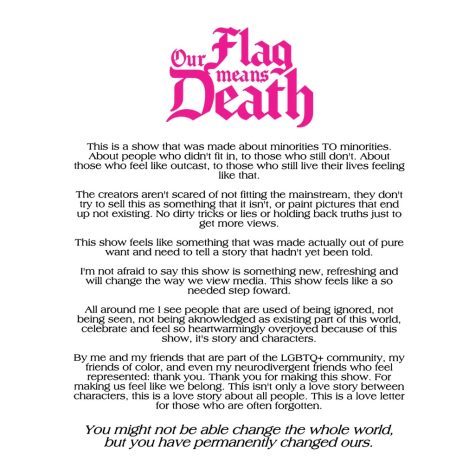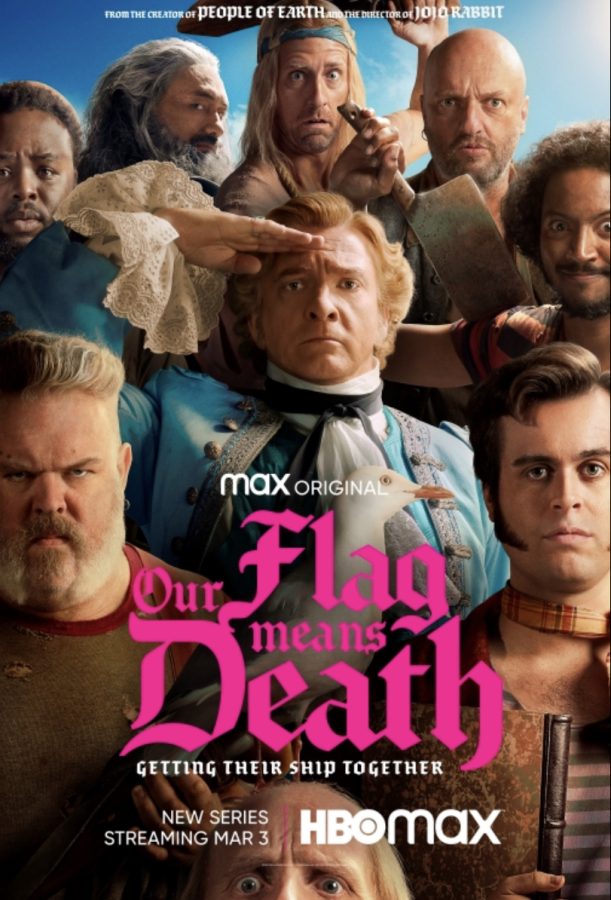Our Flag Means Death’s success proves that the television industry has been waiting for something like this
HBOMax’s Our Flag Means Death stars Taika Waititi and Rhys Darby
Gay pirates and Taika Waititi—that was all I needed to hear before I was completely on board the Our Flag Means Death ship, legs firmly planted on the deck.
But the initial allure could hardly compare to the revelry that unfolded from the first episode and the noticeable hue that has since colored my emotional wellbeing.
Since the first season finished airing on March 24th, I’ve seen Our Flag Means Death in its entirety three times, a fact I take pride in; it’s a new adventure every time I dive in again, and there is no end to the depth of my appreciation for every element and nuance of this show.
In five episodes, each about a half-hour long, Our Flag Means Death follows Stede Bonnet (Rhys Darby)—an aspiring pirate captain whose wealthy, aristocratic background and goofy, lovable, but generally soft, personality render him out of place on the high seas—alongside his eccentric crew, who are understandably skeptical of him. However, Bonnet and his crew find their understanding of pirateering revolutionized when a chaotic turn of events ushers in Taika Waititi’s Blackbeard—a looming legend within the pirating world.
Although the premise is loosely based in reality around the lives of the real-life Stede Bonnet and Edward Teach, otherwise known as Blackbeard, Our Flag Means Death quickly diverges into a realm of copious historical inaccuracies, but that’s all part of the charm and humor that are integral to the show.
As executive producer on the show, alongside David Jenkins, Waititi’s influence is apparent, even though he only directed one episode and doesn’t hold a position as a writer. The sarcastic and somewhat absurdist humor is in a similar realm as some of Waititi’s other projects—Thor: Ragnarok, Jojo Rabbit, What We Do In The Shadows, and beyond.
This humor is one of Our Flag Means Death’s greatest strengths; from recurring inside jokes to caricatures of different European groups, it draws you in and creates a wackily warm and lovable foundation from which to build off.
From the humble roots of this humor grows a delicate balance between humor and emotional vulnerability, developing real stakes and laying everything on the line time and time again. This balance was shocking in its fluidity, but not shocking in the sense that I couldn’t keep up.
But while the comedy welcomed me in and the plot and intensity left me with questions I desperately needed answers to, the characters were the reason I stayed. I’ve always preferred a character-driven story, and I’ve always been one to unreasonably attach myself to the characters in the movies, shows, and books I consume, so it’s hard to say I’m surprised, but Our Flag Means Death is at a caliber unlike anything I’ve ever seen.
The characters aren’t stereotypes of people like them or the epitome of a singular trait—rather, they are well-rounded and lovable because of their multifacetedness and imperfections. Their stories and backgrounds come to light through careful build-up and reveal of secrets, adding another degree of investment.
I’ve mulled over favorite characters with every person I know who’s seen the show, but there’s no consensus—even the villains are hard to hate because of how stunning they are. With every rewatch, I fall more in love with every single character.
But beyond the captivating story, there is so much to analyze within Our Flag Means Death—enough symbolism, metaphors, and parallelism to create an English student’s paradise. Even with all of the information that my partner collected for the 56-slide presentation that they showed our friends after we finished watching the show, there are new epiphanies every time I rewatch it.
This stellar quality in every arena can only be attributed to the team of writers and the unique perspectives they bring to the table. While it can often be obvious when a writers’ room lacks diversity in backgrounds and lived experience, Our Flag Means Death is quite the opposite; it’s extremely clear how many different types of people are offering their voices and being heard.

The show’s cast of LGBTQ+ characters perfectly illustrates this. Not only are there multiple canonly gay characters and a canonly non-binary character, but the way their identities are handled is so insanely impactful and meaningful to LGBTQ+ audiences that have experienced inaccurate, stereotypical, harmful, or entirely nonexistent representation in the media, time and time again.
None of the characters have to come out; they are all immediately accepted and respected for their various identities, painting a picture of a world where LGTBQ+ people don’t need to fight to be loved for who they are.
Our Flag Means Death came in and proved everyone who’s ever claimed that the world wasn’t ready for this yet wrong—dissolved any excuse that’s ever been made for mediocre or nonexistent representation.
Shortly after its finale, it surpassed Euphoria, Book of Boba Fett, Moon Knight, and more as HBOMax’s most in-demand show, and it currently has a 91% critic rating and 95% audience rating on Rotten Tomatoes. With an already devoted fanbase, a star-studded cast, clearly passionate showrunners, and a crazy cliff-hanger ending, things are looking up for a second season renewal.
Above all else, Our Flag Means Death is beautiful—in its characters, plot, humor, representation, and stunning cinematography—and it’s what the world was waiting for.

Natalie Mix is a senior taking on her fourth and final year as a member of The Central Trend. Room 139/140 and the staff of The Central Trend have been...



























































































Sara • Jan 25, 2024 at 1:33 pm
This is a lovely article, and you seemed to be very touched by the show, have you considered writing another article since the cancelation news?
Fans have been devastated that they canceled the show, despite a second season of high ratings (Rotten Tomatoes 93%), award nominations (GLAAD, QUEERTIES), and being their #1 comedy series?
Fans are campaigning to renew the series or get it adopted by another streamer, with a petition that has over 80,000 signatures, raising $17,000 for charity (rainbow YOUTH), and a website RenewAsACrew The impact this show has had on viewers has literally changed lives, just reading the comments on the petition will make you cry.